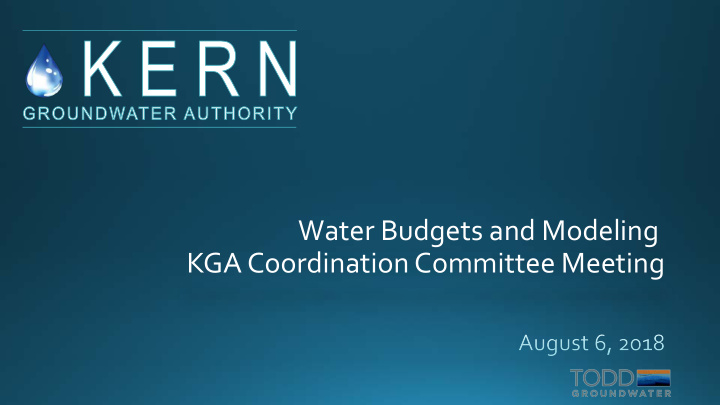



Water Budgets and Modeling KGA Coordination Committee Meeting
CA Water Foundation DRAFT
DRAFT
GSP Requirements Focus on current and historical budgets first Must cover entire subbasin DRAFT
DRAFT
KRGSA Water Budgets - GSP • Develop inflows and outflows for WB zones in KRGSA (without subsurface inflows and outflows) • Scale up to a KRGSA Water Budget for the GSP Subbasin Water Budgets - Groundwater Model • Incorporate water budgets into the Subbasin groundwater model • Combine with other subbasin water budget data • Use model for Subbasin Water Budget; KRGSA using model to estimate local subsurface inflows and outflows DRAFT
DRAFT
• Develop WB data at the agency level • KCWA Improvement District No. 4 (ID4) • City of Bakersfield Water Resources KRGSA Water • Kern Delta Water District Budget • Incorporate additional agencies/areas: • Cal Water, Greenfield County WD, East Niles CSD, Smaller Entities NOR/OMWC, Berrenda Mesa, Rosedale Ranch ID, water budgets Vaughn WC, Lamont CSD, Kern County, other pumping or wastewater; additional “white areas” Larger Agency water budgets • Combine for a KRGSA Water Budget • Groundwater and Surface Water • Document space and time DRAFT
• Inflows to WPP • Banking outside of KRGSA • In-District Recharge • Recovery pumping • Private in-district pumping • Treated water deliveries DRAFT
Kern River diversions • for treatment and use Kern River deliveries • outside KRGSA Treated SWP from • ID4 Inflows: Managed Recharge • Urban Return Flows • Treated wastewater recharge • and irrigation return flows Precipitation infiltration • Stormwater conservation • Outflows • Municipal and Recovery pumping DRAFT
SWP Imported Water • Agricultural ET demand from METRIC ET data • Diversions and managed recharge from District and KR Annual Reports • ET demand not met by Banking surface water assumed imports and pumped from groundwater exports • Dairies and food processing pump groundwater, consume small amounts, then recirculate for irrigation and recharge DRAFT
C2VSim – DWR regional planning model released May 2018 Use C2VSim model for subbasin water budget analysis Revise managed water supply and demand data with local subbasin data Maintain current model structure (layers and properties) Incorporate other existing data already in the C2VSim (e.g., soils) DRAFT
Update Managed Water Supply and Demand Data Surface water diversions by water district Groundwater banking and recharge programs Groundwater banking recovery for in-basin use and export M&I water use Locally important water budget components Crop demand based on METRIC ET data DRAFT
Monthly data 1994-2015 (except 2012) METRIC ET Use for Irrigated Annual Agriculture Average Assign ET 2014 averages to 21 crop types in each of 3 subregions Evapotranspiration (ET) Map crops to inches model elements (can map multiple crops/element) DRAFT
Model simulates key hydrological processes Surface Land and Water Use, Root Zone, and Unsaturated Zone Surface water deliveries from rivers and canals Groundwater flow Focus on physical water Where does the “wet water” go? (not paper exchanges) Prevent “double-counting” DRAFT
Automatically adjusts diversions and pumping to meet demands following user-defined rules Uses surface water, groundwater, and precipitation to meet water demand for different land uses Root Zone water budget tracks: Surface runoff Consumptive use Deep percolation to groundwater DRAFT
Calculates agricultural demand based on soil moisture budget Monthly METRIC data used to generate crop ET time series to determine crop demand Tracks change in soil moisture content throughout simulation If soil moisture falls below minimum level (wilting point), irrigation water added to reach target level (field capacity) to cover ET, deep percolation and runoff DRAFT
DRAFT
Tracks surface water delivered for agricultural and urban use Directs diversions to designated subareas Each subarea provides for spatial distribution of agricultural and urban use Surface Water budget tracks: Diversions River and canal seepage Groundwater-surface water interactions Natural inflows and outflows DRAFT
Calculates runoff and inflow from adjacent small watersheds Uses Soil Conservation Service methods for estimating runoff Systematic method to track inflow from unmeasured watersheds Small Watershed budget tracks Surface water runoff into basin Infiltration of runoff to groundwater Subsurface inflow into basin DRAFT
Groundwater process integrates the inflows and outflows from other processes and simulates Flow through aquifers Groundwater pumping (unless designated) Subsidence Groundwater budget tracks: Volume for each inflow and outflow component Storage change over time Change in groundwater levels DRAFT
DRAFT
DRAFT
DRAFT
DRAFT
Recommend
More recommend